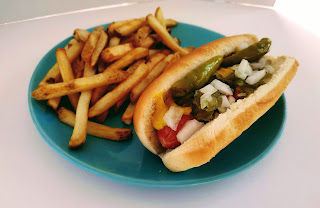Before the Chicago-style hot dog, there was the Depression dog. A more scaled-down version of the Chicago-style hot dog with its many toppings, the Depression dog is topped with only mustard, onions, sport peppers, and sometimes relish. It comes on a plain bun and is usually served with french fries that are either wrapped up with the dog or tossed on top of it. As the name suggests, Depression dogs were popular in Chicago around the time of the Great Depression (1929-1941).
When looking at the origins of the Depression dog, it becomes clear that hot dogs and immigrants are closely linked. German immigrants brought sausage to the United States, and hot dogs became a popular street food in all major American cities that had German immigrant populations. The name “hot dog” was coined around 1890 and came from claims at the time that immigrants ate dogs and cats. (History repeats itself.)
During the Great Depression, vegetable cart owners in Chicago would sell hot dogs and fries with whatever vegetables they happened to have. Eventually the mustard-relish-onion-sport pepper combo became popular, and the Depression dog was born. Depression dogs sold for around a nickel, and Chicagoans liked them because they were cheap, convenient, and able to be eaten on the go. Also, they were filling; you couldn’t go wrong with a Depression dog because it had both meat and carbs, and the toppings practically made it a full meal.
After World War II, the economy improved and more toppings were added to hot dogs. As the Chicago-style hot dog came on the scene, the Depression dog faded in popularity. However, some places still serve up Depression dogs today. Gene and Jude's in River Grove, 35th Street Redhots in Bridgeport, and Redhot Ranch (with locations in Lakeview and Bucktown) all serve Depression-style dogs, although they now most certainly cost more than a nickel. You can also make your own at home. In my opinion, fewer toppings means that Depression dogs are easier to eat, and the flavors all meld together nicely.
Depression Dogs
*based on a recipe from Jeff Mauro of the Food Network
Ingredients:
4 all-beef hot dogs (To be a real Chicagoan, use Vienna Beef.)
4 plain hot dog buns
yellow mustard
relish
about 2 tbsp. chopped raw white onion
sport peppers
Directions:
Grill, steam, or boil the hot dogs. Place them on the buns. Top each dog with mustard, relish, chopped onion, and 2 or 3 sport peppers.

Comments
Post a Comment